If you want to create varied and interesting blues guitar solos, I would strongly recommend getting to grips with the major pentatonic scale.
As you might have guessed from the name, the major pentatonic scale is closely related to the more commonly used minor pentatonic scale.
The latter is a scale with which most guitarists are familiar in some way or other. And in fact it is the first scale that many guitarists learn. I outlined the many reasons for this in my article: ‘A Beginner’s Guide To The Minor Pentatonic Scale‘.
In short though, the minor pentatonic is easy to learn and implement. You can use it to solo over both minor and major chord progressions, and in a wide variety of rock and blues contexts.
Not only this, but the minor pentatonic has been used to craft a huge number of famous riffs and guitar solos.
It was used extensively by some of the most notable blues and blues-rock guitarists of all time, including Eric Clapton, Stevie Ray Vaughan, Gary Moore, Jimmy Page, Albert King, Peter Green and Jimi Hendrix, amongst countless others.
The major pentatonic scale has many similarities to the minor pentatonic. Yet despite these similarities, there are also a number of key differences between the scales. These are explained in much more detail below. But in short, they make the major pentatonic scale a little more difficult to implement effectively.
This often causes guitarists to give up on the scale, and revert to relying solely on the minor pentatonic. Yet the differences and added complexities of the major pentatonic scale are also what make it sound so brilliant.
Learning the major pentatonic scale will give you a new and different sound, and help your playing to stand out. This is because there are fewer guitarists who can use the major pentatonic effectively. And as such, it is used much less frequently than the minor pentatonic.
If you are not yet fully comfortable with the minor pentatonic scale, then I would first read my article: ‘A Beginner’s Guide To The Minor Pentatonic Scale‘ before you dive in here.
If however you are well acquainted with the minor pentatonic, then it is time to take your blues and rock soloing to the next level by using the major pentatonic scale.
In this article then, I outline everything you need to know about the major pentatonic scale. I cover:
- The shapes of the major pentatonic scale and how to play them
- The key differences between the major and minor pentatonic scales
- How to effectively use the major pentatonic scale in your lead playing
- Examples of famous songs that utilise the major pentatonic scale
Without further ado then, here is everything you need to know about the major pentatonic scale:
What is the major pentatonic scale?
Before we look at the major pentatonic scale and how to implement it in your playing in more detail, it is first worth understanding how the scale is constructed. And to do this, we need to look at some basic scale theory.
Don’t worry – I won’t get too deep into music theory here; I will just cover the essentials. This will help to give you a greater understanding of what you are actually playing, which is important.
To understand how the pentatonic scales are created, we need to first look at the major scale. This provides us with the basis of Western music. All other scales are spoken about in relation to this scale.
The major scale is a ‘heptatonic scale’. This is because it is comprised of 7 notes per octave (hepta meaning 7). The scale ‘formula’ of the major scale is as follows:
1 2 3 4 5 6 7
Each of the numbers above relate to a note from within the major scale. 1 is the first note of the scale, 2 is the second and so on. In the key of A, the notes of the major scale are as follows:
A B C♯ D E F♯ G♯
Each of the numbers 1-7 corresponds to one of the notes above. A is 1, B is 2 and so on. This scale formula is always used as the reference point when talking about other scales.
Let’s look at the minor scale for example. The scale formula for the minor scale is as follows:
1 2 b3 4 5 b6 b7
In the key of A, this changes the notes of the scale. The 3rd, 5th and 6th notes have all been flattened. And this reduces their pitch by a semi-tone. So the notes of the minor scale in the key of A are as follows:
A B C D E F G
The 3 notes mentioned above have all been flattened by a semi-tone. So the sharps that were present in the A major scale do not appear here.
Pentatonic scale construction
Although the major scale provides the foundation of most Western music, it is very rarely used in the form noted above. This is because it lacks some of the edge and tension that we like to hear when listening to popular forms of music.
Instead, scales that are derived from the major scale – as well as the minor scale – appear with greater frequency. The minor and major pentatonic scales are just some examples of these scales.
A pentatonic scale is a scale that is made up of only 5 notes per octave (penta meaning 5).
The minor pentatonic scale is derived from the minor scale and has the following scale formula:
1 b3 4 5 b7
So it contains notes from the minor scale, but it only contains 5, rather than 7 notes.
Conversely, the major pentatonic scale is derived from the major scale and has the following scale formula:
1 2 3 5 6
This changes the notes that are used in each scale. In the key of A for example, the notes in the 2 different pentatonic scales are as follows:
Minor Pentatonic Scale – A C D E G
Major Pentatonic Scale – A B C# E F#
These differences fundamentally change the way that the minor and major pentatonic scales sound. They also change the context in which you can play them.
How to play the major pentatonic scale
When it comes to learning the major pentatonic scale, there is good news: you don’t need to learn any new scale shapes. This is because the major pentatonic scale has exactly the same shapes as the minor pentatonic scale.
The only difference is that these shapes are found on different parts of the fretboard. Specifically, they are always 3 frets lower than the shapes of the minor pentatonic scale.
To dig into this in more detail, let’s first recap the shapes of the minor pentatonic scale. We will look here at the scale shapes as they appear in the key of A:
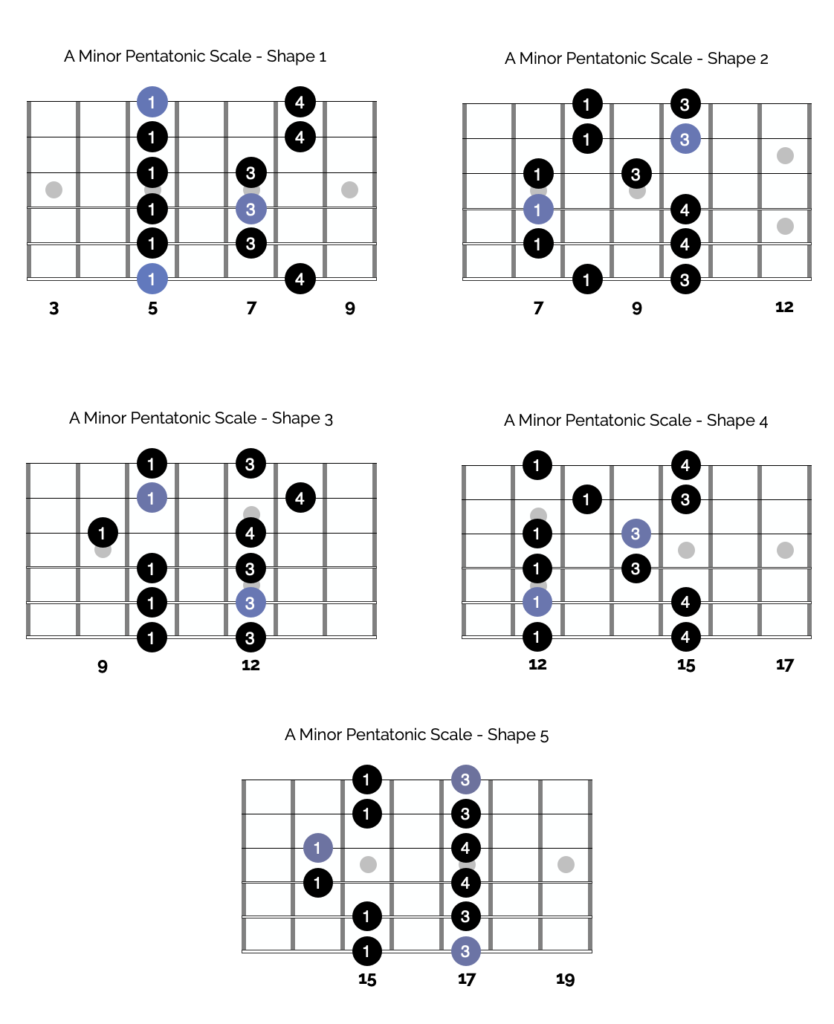
The scale diagrams here show the notes of the scale and the fingerings I recommend you use to play those shapes. They also show the root and octave notes of the scale, which in this case are the notes of ‘A’.
Now let’s look at the 5 shapes of the major pentatonic scale in the key of A:

As you can see, the scale shapes are exactly the same. The only difference is that in the case of the major pentatonic scale, they appear 3 frets lower than the same shapes in the minor pentatonic scale. This is always the case, regardless of the key in which you are playing.
On the one hand, this trick is very useful. It saves you from having to learn more scale shapes, and it is very easy to apply straight away.
Yet in some ways this same trick has the potential to cause you problems in your playing. There are 2 reasons for this, which are as follows:
1.) It leads you to believe that the major and minor pentatonic scales are almost identical. If you take this approach, you can end up attempting to play the same licks when you solo with the major pentatonic, as you do when using the minor pentatonic. In other words, you don’t change your soloing approach at all between the scales. All you do is move your hand down 3 frets. As I will explain in more detail below – and as you may have already experienced for yourself – this approach doesn’t work that effectively.
2.) This trick prevents you from looking at the ways that the 2 different scales overlap. As I will explain in greater detail below, all of the pentatonic shapes – both minor and major – overlap each other. And so if you view the major pentatonic scale as always 3 frets lower than the minor pentatonic, you miss out on many of the brilliant opportunities to mix the 2 scales effectively.

The minor vs. the major pentatonic scale
So, whilst the ‘trick’ explained above is a useful starting point to help you learn the major pentatonic scale, to really understand how to use it, we need to dig a bit deeper.
And the best way to do this is to look at the differences between the 2 scales. For although the similarity in the shapes can lead you to believe the minor and major pentatonic scales are identical, their differences are profound.
This all stems from the fact that they are different scales. I am aware this sounds painfully obvious – but it is a point that a lot of guitarists overlook.
They learn the trick that unlocks the shapes of the major pentatonic scale, and fail to understand that it is a totally different scale. It contains different notes and the intervals between the notes in the scale are different.
At this point then it is worth really highlighting the differences between the minor and major pentatonic scales. And we can do this by looking at the major pentatonic scale in relation to the minor pentatonic.
This is a natural starting point, because the minor pentatonic is more widely used than the major pentatonic and is typically the first scale that many guitarists learn.
Compared with the minor pentatonic scale, the major pentatonic scale:
- Has a more upbeat and happy sound
- Can only be used over major and dominant chord progressions
- Is more difficult to implement in your blues playing, because it clashes with certain chords in the 12 bar blues progression
- Is rarely used as the only scale in blues and rock guitar solos
There is a lot of material to cover here. So to keep things simple, we can split these points into 3 different categories. And these are as follows: why you should you use the major pentatonic scale, the key rules to follow when you use the major pentatonic and how you can use it effectively in your playing.
Why you should use the major pentatonic scale
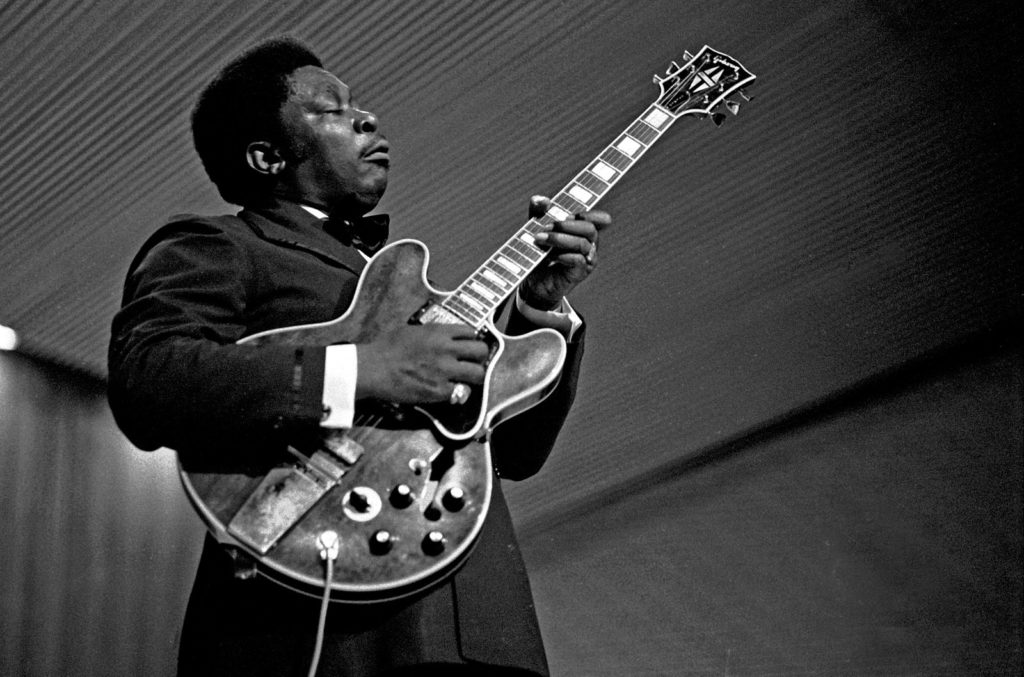
Unfortunately, a lot of aspiring blues guitarists give up on the major pentatonic scale almost as soon as they’ve discovered it. And it is easy to see why this is the case.
The major pentatonic is more complex and less versatile than the minor pentatonic.
And given how well the minor pentatonic scale works in a blues and blues rock context – and also how much mileage you can get from the scale – it is easy to become overly reliant on the minor pentatonic. Yet doing so is detrimental to your lead guitar playing.
There are 2 main reasons that you should learn and use the major pentatonic scale in your lead guitar playing. And these are as follows:
The major pentatonic sound
The major pentatonic scale has a fundamentally different sound to the minor pentatonic.
In simplistic terms – songs, chords and scales that are minor have a sad and melancholic feel. Conversely – songs, chords and scales that are major have a happy and upbeat feeling. And that is certainly true of the major pentatonic scale. It has a brighter, happier and less edgy sound than the minor pentatonic.
At first, this might sound like a drawback. After all, there is something counterintuitive about opting for a happy sounding scale when playing the blues.
Yet whilst this is true – and a happy and upbeat sound is not always going to be appropriate – it is important to have the option to choose what type of sound you want to create in your blues guitar solos.
The minor pentatonic scale sounds brilliant and works well in a huge range of different situations. But you don’t want to limit yourself to that one sound. And the first step to expanding your musical vocabulary is to learn the major pentatonic scale.
The major & minor pentatonic mix
If you have predominantly been playing the minor pentatonic, then learning the major pentatonic scale will essentially double your musical vocabulary. But it will actually do more for your playing, as it also opens up a whole range of further options.
For a number of reasons that I will explain in more detail below, it is unusual for the major pentatonic scale to be the only scale used in blues and blues-rock guitar solos.
Instead, it is much more common for it to be combined with the minor pentatonic.
This creates a huge range of different soloing options and allows you to create a rich and varied sound. B.B. King, Stevie Ray Vaughan, Eric Clapton and Jimi Hendrix are just a number of notable blues guitarists who combine the major and minor pentatonic scales to great effect in their lead playing.
So whilst learning the major pentatonic will unlock a whole new scale and sound to use in your playing – more significantly, it will give you the option to mix the major pentatonic scale into all of your current licks.
The 2 key rules of the major pentatonic scale
I hope by this point that I have convinced you of the benefits of using the major pentatonic scale in your blues lead playing. So now we need to shift our focus on how to actually implement it. And here it is easiest to start with the 2 most important rules that you need to follow when using the scale. These are as follows:
1.) Play the scale over major & dominant chord progressions
The minor pentatonic scale is so versatile because you can use it over both major and minor chord progressions in most blues and rock contexts.
If for example you are playing over a 12 bar blues progression, you can use the minor pentatonic scale, regardless of whether the progression is in A minor or A major. That you are able to do this, defies the rules of music theory.
Mixing minor and major tonalities shouldn’t really work or sound good. But in fact it sounds brilliant. And more than that – it has created a sound that we have now come to associate with blues and blues-rock music.
The opposite is not true of the major pentatonic scale. If you try to play the major pentatonic scale over a minor chord progression, it will not sound good. This is because the notes of the major scale clash with those found in minor chords. And this creates a harsh dissonance.
So, when you are starting out with the major pentatonic scale, keep in mind that you are not able to use it over minor chords. Instead, use it over major chord progressions and chord progressions that use dominant chords.
If you aren’t yet familiar with dominant chords, then I would recommend first reading this article that I wrote on the topic. This explains dominant 7th chords – which appear in most 12 bar blues progressions – in more detail.
2.) Avoid the IV chord
Now, the reason that most guitarists struggle to implement the major pentatonic scale, is that even within a 12 bar blues context, you can’t play the scale over the whole progression.
I cover the 12 bar blues form in a lot more detail here – so if you are new to this material, I would recommend reading that article first. As a quick recap though, a typical 12 bar blues progression is comprised of the I, IV and V chords in any given key.
In the key of A, this gives you the chords of A7, D7 and E7. Below I will discuss the different options you have when soloing over a 12 bar blues progression. But for now let’s focus on that D7 chord. There are numerous different ways to play this chord, but one of the most frequently used is like this:
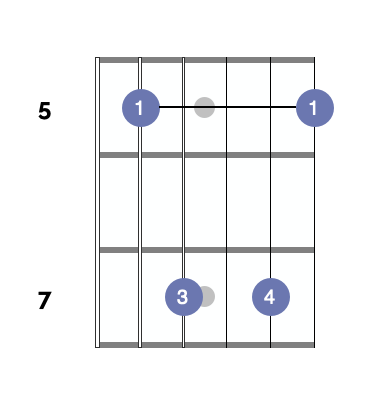
You can’t play the major pentatonic over this chord, because there are certain notes within the scale that clash with those in the chord. In the key of A major for example, the major pentatonic scale contains the note C#.
This note clashes with the C note in the D7 chord and produces a dissonant and unpleasant sound. You can see this here:

The blue circles show the notes that appear in the D7 chord. Many of the notes that appear in the major pentatonic scale in this position, also appear in the chord. The white circles show the additional notes that appear in the scale, but not in the chord.
Finally, the red notes show those 2 notes in the major pentatonic that clash with the notes found in the chord. This is what it sounds like when you play that C# note against the C in the chord:
As you can hear, it sounds awful. And whilst you can play the scale and avoid that note, it is difficult to do so.
Below I cover in more detail what you should do when the 12 bar blues progression shifts onto the IV chord. But for now, just remember that it is hard to sound good when you play the major pentatonic over the IV chord in a 12 bar blues progression.
How to use the major pentatonic scale
Whilst these rules might make the major pentatonic scale sound overly complicated, they are easier to implement than you might think.
Here is a rough guide on how you can use the scale and play it alongside the minor pentatonic over a 12 bar blues progression. The example I use here is in the key of A, but you can apply this same idea to different keys.
A7
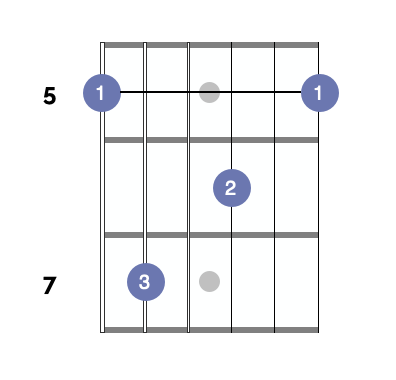
Over the I chord in a major 12 bar blues progression, you can choose to play either the minor or the major pentatonic scale.
Both will sound great, and so the choice depends largely on the type of feel that you want to create in your solo.
To an extent, the opening bars of your solo will establish the feel you create. If you open using the major pentatonic scale, you will establish a brighter and more upbeat sound to your playing.
Conversely, if you choose to play the minor pentatonic, you will create a heavier and more edgy feel.
You can of course choose to mix the 2 scales over the I chord as well. And I cover how you can do this effectively in more detail below.
D7
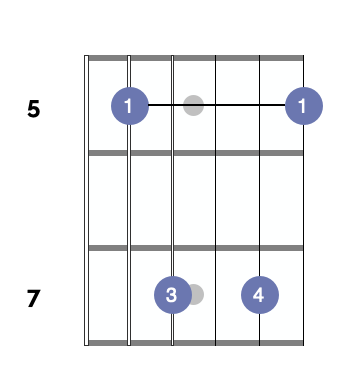
As mentioned above, when the 12 bar blues progression moves to the IV chord, I would recommend playing the minor pentatonic scale.
So in the key of A major, playing the A minor pentatonic would be my top choice. There aren’t any notes within the A minor pentatonic scale that clash with the D7 chord. As such, you can solo freely without worrying about hitting the wrong notes.
Additionally, if you have been soloing using the major pentatonic over the I chord, then switching to the minor pentatonic will add greater variety to your soloing.
Over the IV chord, you also have the choice to solo using the minor pentatonic that relates to the IV chord. So in the key of A, when the progression switches to D7, you could also solo using the D minor pentatonic scale.
Having said that, if you are just starting out with this material, I wouldn’t recommend going down that route at first.
This is because it requires you to think about a greater number of scale patterns and positions on your guitar’s neck. And if you are new to the major pentatonic scale, I would recommend breaking down the challenge of using it into small chunks.
E7

In the key of A, the last chord to appear in a typical 12 bar blues progression is an E7.
As when you play over the I chord, here you can use both the major and minor pentatonic scales. And as noted above, the scale that you choose will be determined by the feel that you want to create.
As is the case when the 12 bar blues progression moves to the IV chord, you also have the choice here to play the scale related to the chord. In this case that would be the E minor pentatonic scale. Here though, you also have the choice to play the E major pentatonic scale. So over this chord you have a whole range of different choices. You can choose to play any of the following:
- A major pentatonic scale
- A minor pentatonic scale
- E major pentatonic scale
- E minor pentatonic scale
As before, if you are new to this material – don’t make life difficult for yourself. Don’t worry about moving to the E minor or major pentatonic scales. Instead, just stick on the A pentatonic, and experiment with moving between the major and minor pentatonic scales.
Keeping it simple
The key to getting to grips with the major pentatonic scale is to take it one step at a time. There is more to think about when using this scale, and it requires you to take a slightly more sophisticated approach to soloing.
You can’t just play one scale without worrying about where you are in the chord progression – as you can when using the minor pentatonic scale.
Instead you have to ‘play the changes’. You need to have an awareness of where you are in the chord progression, and then change your soloing approach accordingly. This is not easy to do at first. And so if in doubt, keep things nice and simple:
- On the I chord, play either the major or minor pentatonic scale
- When the progression switches to the IV chord, play the minor pentatonic scale
- On the V chord, play either the major or minor pentatonic scale
This will already open up a huge range of possibilities and add richness and versatility to your solos. Then once you get to grips with this idea, you can start to explore some of the further approaches I have noted above.
Mix & match
So far, I have spoken about the minor and major pentatonic scales in either/or terms. But what makes the scale so useful and effective in practice, is that you can mix it very effectively with the minor pentatonic scale. And it is this that will have the greatest impact on your playing.
As I have explained above, you can of course play the minor and major pentatonic scales independently of one another. So on the I chord you can play the major pentatonic, and then move to the minor pentatonic scale on the IV chord.
This works very well, but you can be more sophisticated and subtle in your approach by weaving the scales in together. In other words, over the I chord, you can mix the major and minor pentatonic scales. On the IV chord you can play the minor pentatonic scale. And then over the V chord you can mix the scales again.
This really changes the feel of your playing, and opens up a wide range of possibilities and note choices. We can see this by comparing licks that use just the minor pentatonic scale, with those that use a combination of the major and minor pentatonic scales.
In each of these examples, the first bar is a lick based around the minor pentatonic scale. The second bar is a lick that combines the minor pentatonic scale with the major pentatonic.
On the audio there is a bar of rest in between the licks. This is not shown on the tab, but gives a bit of space between the 2 different licks. All of these licks are in the key of A major.
Lick 1
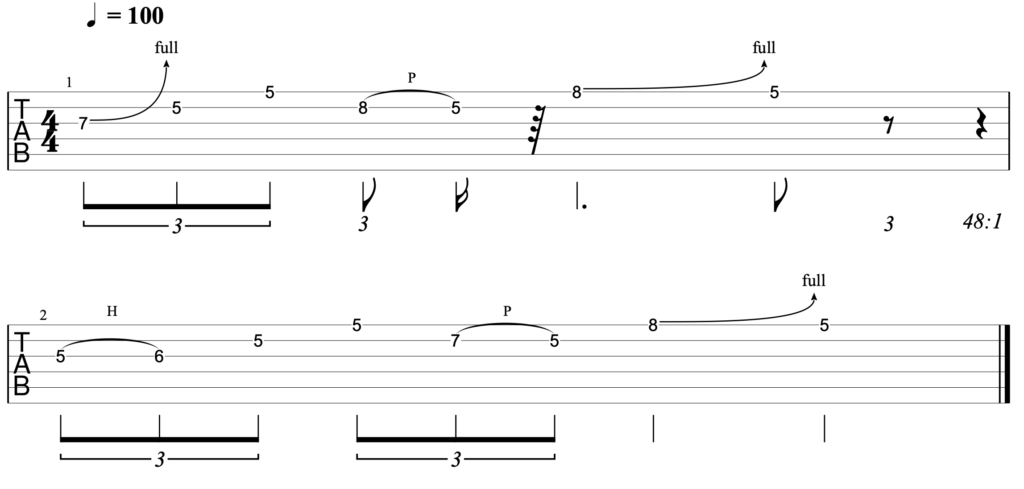
In this first example, we take a lick from shape 1 of the minor pentatonic scale. This lick – and those similar to it – are very common, and are used in countless famous blues and rock solos. It is a great lick and one that I would recommend adding into your solos.
Yet by mixing this shape with the major pentatonic scale, you can create a different sound and feeling. Given that the minor pentatonic is so widely used, this helps your playing stand out and sound interesting and different.
Lick 2

The 3rd position of the minor pentatonic scale overlaps very neatly with the 4th shape of the major pentatonic. This makes it one of the best positions on the fretboard to mix the 2 scales. Again, although the changes in notes are subtle, the feel of the lick is quite different.
Lick 3

Finally, we have another common minor pentatonic lick, which is often used at the start of solos. And again, by making just a small change and adding in some notes from the major pentatonic scale, we can create a different and more unusual sound.
In isolation – none of these 3 major pentatonic licks sounds wildly different from the minor pentatonic ones. But if you construct an entire solo in this way and constantly mix the minor and major pentatonic scales, you will be amazed at how different your lead playing starts to sound.

How to mix the minor & major pentatonic scales
In order to effectively mix the minor and major pentatonic scales in your playing, it is helpful to be able to visualise their shapes and the way they connect.
The ‘trick’ that helps you get to grips with the shapes of the major pentatonic is initially helpful. But once you understand the relationship between the major and minor pentatonic scale, I would quickly move towards looking at how the 2 scales overlap each other.
This will open up a whole range of different options when you are improvising. It will also help you to blend the 2 scales seamlessly, as opposed to having to always shift your hand up and down the fretboard.
Let’s look at this at the 5th fret on the E string. This note – which is A – provides the starting point for the 1st position of the A minor pentatonic scale. It also provides the starting point for the 2nd position of the A major pentatonic scale:
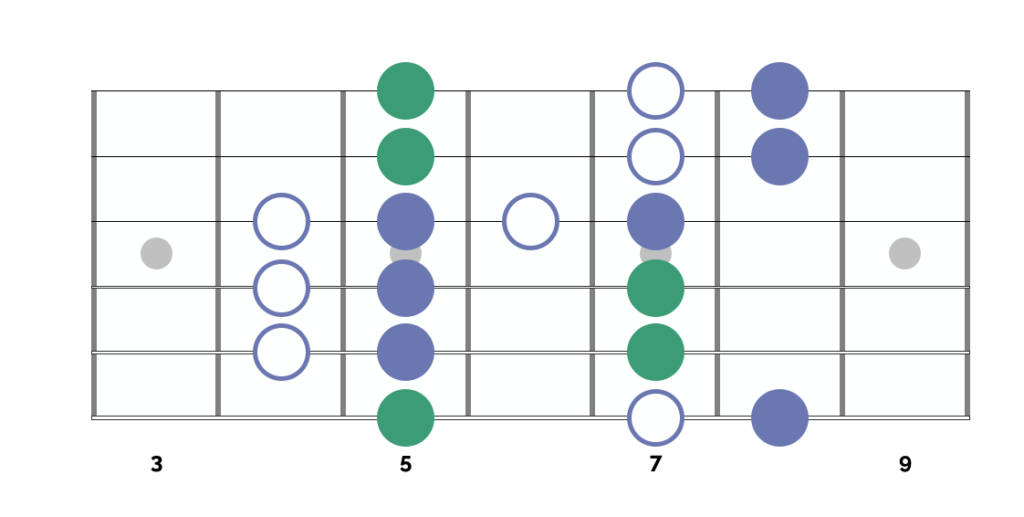
The notes in blue are those that appear in the minor pentatonic scale. The notes in white are those that appear in the major pentatonic scale. And the notes in green are those that appear in both scales.
As you can see then, the 2 scales sit almost directly on top of one another. So instead of always moving down 3 frets when trying to play the major pentatonic, look at how the scale overlaps with the minor pentatonic scale shapes.
The major pentatonic scale in context
To bring some of these ideas to life, below are some examples of blues and blues-rock riffs and guitar solos that use the major pentatonic in different contexts:
- In both of his solos on Cream’s famous cover of Crossroads – Eric Clapton mixes the minor and major pentatonic scales very effectively. He does this in the key of A major.
- Throughout the lead guitar playing in Red House, Jimi Hendrix mixes the pentatonic scales in the key of B flat major. (He plays them in the position of B, but tunes his guitar down a half step).
- In his song, Why I Sing The Blues, B.B. King plays major pentatonic licks in the key of C major.
- In the solo for All Right Now, Paul Kossoff of Free effectively mixes the A minor and A major pentatonic scales.
- The major pentatonic scale is used in both the introduction and the guitar solo in the song Blue Sky by The Allman Brothers Band. This is in the key of E major.
- Throughout the instrumental song Steppin’ Out, by John Mayall & The Bluesbreakers, Eric Clapton mixes the G minor and G major pentatonic scales.
The songs listed above are just some examples. There are a whole range of famous blues and blues-rock songs that have solos and riffs that are constructed using the major pentatonic scale.
But listen to these riffs and solos and try to hear the major pentatonic scale being played and mixed with the minor pentatonic. This will help you to develop a sense of how the scale sounds within the context of a song. And this will be useful when you start to create your own solos and improvisations.
Putting it all together…
In my opinion, learning the major pentatonic scale is the first step to becoming a much better and more versatile blues guitarist. It will greatly increase your musical vocabulary, which will make your playing more interesting and varied.
Not only will this make your lead guitar playing sound much better, it will make your playing more enjoyable.
Take your time to get to grips with the ideas outlined here. The positions of the major pentatonic are not as familiar as those of the minor pentatonic. There are also a few rules you need to follow when you use this scale. To gain a full understanding of how you can use it effectively, really focus on it during your practice.
The key to learning it, is to break it down into manageable chunks and to take your time. It is much better to take a little longer learning the major pentatonic scale – but to properly understand it – than it is to rush in and fail to learn its positions and uses properly.
When I first learnt the major pentatonic scale, I spent a lot of time practicing and experimenting with it. This helped me to understand how to mix it with the minor pentatonic and to use it in the right context. These were the steps I took:
- To start with, I played the major pentatonic scale shapes up and down the neck, in each of the different positions in the key of A. I played the scale shapes slowly along to a metronome.
- Once I had a solid grasp of the scales and positions of the A major pentatonic scale, I looked at how the 2 pentatonic scales overlap in different parts of the neck.
- At first, I started at the 5th fret on the low E string, as noted above. I then played the 1st position of the minor pentatonic scale alongside the 2nd position of the major pentatonic scale.
- After that, I put on an A major blues backing track and improvised in just this one position. I went through the process of playing and experimenting with the major pentatonic scale over the different chords in the 12 bar blues. I also practiced mixing it together with the minor pentatonic scale.
- Once I was comfortable playing in that position, I repeated the process in all of the different positions of the scale in the key of A.
- I then started improvising over the backing track using both the A minor and A major pentatonic scale. My aim here was to ‘meander’ across the fretboard. I wanted to move between each of the different positions as much as possible. This helped me to get familiar with how the 2 scales relate to each other across the neck.
- After I felt comfortable soloing in the key of A, I repeated the process in B and C etc.
This might all sound a bit dull and long winded, but in fact it was a lot of fun. For the most part I was just jamming along to backing tracks. This brought the scale to life and helped me to engrain the shapes in a more musical and practical way.
If you are finding it tricky to use the major pentatonic and mix it with the minor pentatonic, give this a go. I think it will really help you.
If you find yourself struggling though, or if you have any more in depth questions on the subject please do let me know. Drop a note in the comments section, or send me an email on aidan@happybluesman.com. I’d love to help.
Good luck guys!
P.S. If you enjoyed reading this article, please share the love 😁 Thank you!
References
Guitar World, Youtube, Guitar Theory for Dummies, Complete Guide to Playing Blues Guitar, Premier Guitar, Wikipedia, Fret Jam, Guitar World, Justin Guitar, Blues Guitar Institute, Guitar Interactive Magazine, My Guitar Workshop
Images
Image of B.B. King – Heinrich Klaffs (Flickr) The license for this image is here
Feature Image – Daniel Prado (Unsplash)





Responses
HELLO!! I just wanted to thank you for this article. It clicked today about mixing minor and major in my soloing! You’ve bumped my playing up, thanks!
Until the next plateau, peace!
Hi Jonis, thanks so much for the comment and for the kind words, they made my day! I’m really glad to hear that the article helped and that you’ve started to combine the major and minor pentatonics in your solos – it is an awesome moment when it ‘clicks’ 😁 If you ever have any more questions or if there is anything else I can help with, please do let me know. Just send an email through to aidan@happybluesman.com and I’m always happy to help!
Excellent info!! I just learned the minor pentatonic and now moving into the major pentatonic scale. Can you still do big bends in lots of vibrato in the major pentatonic ? I know I have heard people say you can not use the same licks as the minor pentatonic .
Thanks so much for the kind words Earl, I really appreciate it. It sounds like you’re absolutely flying, which is brilliant!
To answer your question, you can definitely still do big bends when you are using the major pentatonic. The difference is that the notes you are likely to bend, and how you resolve your phrases will be different to when you are using the minor pentatonic scale.
As such, if you try and take the phrases and licks that you have been using in the minor pentatonic, and copy them across to the major pentatonic scale, they probably won’t sound quite right. If you are just getting started with these two scales, I would recommend focusing on really getting to grips with the minor pentatonic scale first. This is partly because it is easier to learn implement, but also because it is arguably more versatile. Use that as your ‘go-to’ scale to begin with, and then slowly work on adding in notes from the major pentatonic scale; rather than making a complete switch away from the minor pentatonic scale.
I hope that helps, but if you do have any more questions – just send them over to aidan@happybluesman.com. I am always around and happy to help
Five months after my first comment about mixing the minor and major pentatonic … I have things down with the help of this article. I hear the ” three frets down advice” I think the way you explain it is the easiest way to go. We already have major pentatonic mixed with minor pentatonic. Just mix in the major notes with the minor notes.. just like the BB box.
Mixing the major with the minor has really helped my playing . I know lots of people mix major and minor ..but to me it sounds very BB King . That is who I think of when I play mixing the major and minor.
Thank you so much for the kind words Earl, I really appreciate it. I am so glad to hear that you are getting on well with mixing the minor and major pentatonic scales. This can be a real challenge in the beginning but it is well worth the effort – it gives you so many more options and choices when soloing. And as you noted, it can really help you to create that warmer and sweeter major pentatonic sound, enabling you to create a bit of a B.B. King vibe in your playing 😁
Good luck practicing with it over the next few weeks, and I look forward to catching up again soon!
Thanks so much for this. Question: In the 2nd lick example it says the 3rd position of the minor is overlapped with the 2nd position of the major. But that position on the neck isn’t near the 2nd position of A major. ?
Thank you so much for the kind comment Biff, and for spotting that! It was in fact just a typo, which I have since corrected. It should have said that the third shape of the minor pentatonic overlaps with the fourth shape of the major pentatonic scale 😁 Thanks again, and if you have any more questions – please do send them across. You can reach me on aidan@happybluesman.com and I am always around and happy to help!
Hey Aidan,
Thanks for the brilliant lesson, learnt a lot! I noticed you mixed position 1 of the A minor pentatonic scale and position 2 of the A major pentatonic scale as they overlap each other. My question is, can you do this with the other positions? For eg, A minor pentatonic position 3 with A major pentatonic position 4 and so on for all 5 pentatonic positions? Everytime I see a lesson like this, only position 1 of the A minor pentatonic is mixed with position 2 of the A major pentatonic. I don’t ever see any other pentatonic positions covered.
Hi Hash, thank you so much for the kind comment and I am really glad to hear that you found the article helpful 😁
To answer your question – yes absolutely! The shapes of the minor and major pentatonic scales overlap all over the fretboard. As noted in the article above, if you take any shape of the minor pentatonic scale and shift it down 3 frets, you will find the corresponding shape of the major pentatonic scale. This means that whenever you are playing a familiar minor pentatonic shape, in the same area of the fretboard you will find the next shape along from the major pentatonic scale.
In other words, the second shape of the major pentatonic scale overlaps with the first shape of the minor pentatonic scale. The third shape of the major pentatonic scale overlaps with the second shape of the minor pentatonic scale. The fourth shape of the major pentatonic scale overlaps with the third shape of the minor pentatonic scale. And so on.
Most lessons (this one included) focus on the first position of the minor pentatonic scale, as this is typically the most familiar for players. As a result this makes it easier for guitarists to start mixing the two scales in this part of the fretboard. If however you are getting started on mixing the two scales and you would like to advance beyond the first shape, then inside The Blues Club I have recently uploaded a full video course introducing the major pentatonic scale and how it overlaps with the minor pentatonic scale. This week I will be adding another course that covers 5 pentatonic box shapes where you can mix the two scales. So if you are looking to get to grips with mixing the two scales, I think both of these courses will really help.
Either way, good luck my man! And if you have any more questions or if I can help at all, please do get in touch. You can reach me on aidan@happybluesman.com and I am always around and happy to help! 😁
Fantastic lesson! I am really looking forward to improving my blues solos by incorporating the major scale!
Awesome. This lesson is a godsend. Thank you!!
My pleasure Dave and I am so happy to hear you found it useful. Best of luck dialling in those beautiful major pentatonic licks my man! 😁